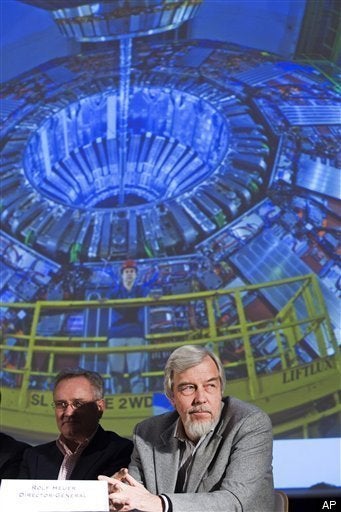
There was some excitement at the Tevatron collider site in the U.S. recently, not because they had found what has been mischievously referred to as the "God particle," but because they had ruled out a quarter of the energy range where the Higgs particle is said to exist. Meanwhile, the contest of the colliders is still on, with researchers at the Large Hadron Collider in Switzerland reasonably confident that they will be in a position to be much more definitive about the all-important particle somewhere in 2013.
The Higgs particle is so important because if found, it would resolve the great mystery that clouds our understanding of how energy gains mass on the way to becoming matter. It has been described as the molasses that acts as the sticky stuff in the universe, serving the formation of matter's atomic building blocks.
Could it be that materialists are waiting to say that the Higgs particle will now replace God? Or that more people will turn to atheism at the realization that God is not sitting there as an instrumental agent who turns invisible forces into stars and planets? Having declared that the Hand of God is really a sticky particle, it will be one more nail in the coffin of the Creator and one more challenge to the idea that consciousness is the first cause, primary field or ground of being out of which everything arises!
"Well, not so fast," says Plato. In his own way, he saw this coming. In his day, he complained that some of the philosophers were beginning to surmise that the universe was chiefly comprised of rocks and gases. He reminded them that the universe has not only measurable quantities but also qualities. These qualities were the progenitors of form: truth, beauty, love, justice, harmony -- all these qualities combined in different degrees to give birth to ideas and to interfuse and give life to diverse forms.
I was recently at the annual Language of Spirit dialogue, instigated 18 years ago by the physicist David Bohm and his Native American counterpart Leroy Little Bear. We are all familiar with the native sense of "all my relations" -- the relatedness of every form in existence. What struck me at this last dialogue was how much the native elders stressed being known by place. They quipped that Westerners are always on the move, and moving into other people's territories, because they never stay long enough to know and be known by place. I found it a startling idea that I could enter a relationship with place to the degree that it became a field of mutual appreciation: maybe that finch on the tree and I could commune rather than its being simply admired by me; perhaps even the qualities in the tree itself could mentor me, or the rocks, stones and crystals could reflect qualities beyond the spectacular geometry of their formation. Is all life looking at itself and its relatives as a reflection in a mirror we call consciousness?
Bohm was so interested in dialogue because it helped open us up to the deep mirror of consciousness itself. He saw the manifest aspect of the universe in space and time as part of an explicate order, and that underlying the substrate of matter is an implicate order, which is generative and holographic. He suggests that there is a "proto-intelligence" in matter because it arises out of an implicate order that is a seedbed of consciousness. "The separation of the two, matter and spirit, is an abstraction," he said.
Meanwhile, the colliders are busy searching the energy range, measured in gigaelectronvolts, where the Holy of Holies, in the realm of physics, may have hidden itself. And even if they manage to nab it, what will it really mean for those of us who believe that as long as spirit is denied, science will continue to live its current schizophrenia as both evocateur of human possibilities and enlightenment and servant of a frighteningly reductionist materialism?
It will mean the difference between whether we see ourselves in a living universe or one designed for machines, for consumption and competition over ever-increasingly limited resources. It will mean the difference between continued rebellion against the Holy Order of Nature or the re-emergence of Nature as our greatest teacher. It will mean the difference between biophilia and necrophilia -- that is, love of life or love of dead things. Loving your right to a gas-guzzling car over protection of the ecosphere is a form of necrophilia. It goes with a consume-junk-and-dump approach, because it's all dead stuff, anyway. With such necrophilia comes the loss of one third of earth's species since 1970 and looming ecological and climate-related catastrophes.
But the lovers of life look for the re-marriage of science and spirituality, where we explore the ground of all being, seek to know it better, appreciate the many ways to understand it and come in some humility to feed from a Holy of Holies that resides inside the Great Mystery. Such knowing opens us to profound states of unity and ecstatic awareness, which no sticky little particle, however brilliant, is capable of delivering on its own.
 An invited contribution to the Ervin Laszlo Forum on Science and Spirituality.
An invited contribution to the Ervin Laszlo Forum on Science and Spirituality.